Hervé- and Krebs-Type Magnetic Polyoxometalate Dimers
Abstract
:1. Introduction
2. Sandwich-Type POM Archetypes
3. Hervé-Type Dimers
3.1. Atypical Hervé Polyanions
3.2. Hervé Polyanions Sandwiching Three Heterometals
3.2.1. Aqua Terminating Ligands
3.2.2. Oxo Terminating Ligands
3.2.3. Other Types of Terminating Ligands
3.3. Hervé Polyanions Sandwiching Two and Four Heterometals
3.4. Hervé Polyanions Sandwiching Five Heterometals
3.5. Hervé Polyanions Sandwiching Six Heterometals
3.6. Hervé Polyanions Sandwiching Mixed-Metallic Cores
4. Krebs-Type Dimers
4.1. Differentiation between Classical Krebs Dimers
4.2. Partial Substitutions in Krebs Dimers
4.3. Ligand Substitution in Krebs Dimers
4.4. Grafting Metal Cations and Interconnecting Krebs Dimers
5. Vision on POMtronics
6. Conclusions
Author Contributions
Funding
Conflicts of Interest
Abbreviations
| apyr | aminopyrazine |
| bpy | bipyridine |
| btp | 1,3-bis[tris(hydroxymethyl)methylamino]propane |
| DMSO | dimethyl sulfoxide |
| imi | imidazole |
| mimi | 1-methylimidazole |
| ox | oxalate |
| POM | polyoxometalate |
| POT | polyoxotungstate |
| pdc | pyridine-3,4-dicarboxylate |
| pyzdc | pyrazine-2,3-dicarboxylate |
| pic | 2-picolinic acid |
| pyr | pyridine |
| taz | 1,2,4-1H-triazole |
| thr | threonine |
References
- Gaita-Arino, A.; Prima-Garcia, H.; Cardona-Serra, S.; Escalera-Moreno, L.; Rosaleny, L.E.; Baldovi, J.J. Coherence and organization in lanthanoid complexes: From single ion magnets to spin qubits. Inorg. Chem. Front. 2016, 3, 568–577. [Google Scholar] [CrossRef]
- Bertaina, S.; Gambarelli, S.; Mitra, T.; Tsukerblat, B.; Muller, A.; Barbara, B. Quantum oscillations in a molecular magnet. Nature 2008, 453, 203–206. [Google Scholar] [CrossRef]
- Hill, S.; Edwards, R.S.; Aliaga-Alcalde, N.; Christou, G. Quantum coherence in an exchange-coupled dimer of single-molecule magnets. Science 2003, 302, 1015–1018. [Google Scholar] [CrossRef] [PubMed]
- Cerletti, V.; Coish, W.A.; Gywat, O.; Loss, D. Recipes for spin-based quantum computing. Nanotechnology 2005, 16, R27–R49. [Google Scholar] [CrossRef]
- Atzori, M.; Morra, E.; Tesi, L.; Albino, A.; Chiesa, M.; Sorace, L.; Sessoli, R. Quantum Coherence Times Enhancement in Vanadium(IV)-based Potential Molecular Qubits: The Key Role of the Vanadyl Moiety. J. Am. Chem. Soc. 2016, 138, 11234–11244. [Google Scholar] [CrossRef] [PubMed]
- Baldovi, J.J.; Cardona-Serra, S.; Clemente-Juan, J.M.; Coronado, E.; Gaita-Arino, A.; Palii, A. Rational design of single-ion magnets and spin qubits based on mononuclear lanthanoid complexes. Inorg. Chem. 2012, 51, 12565–12574. [Google Scholar] [CrossRef]
- Stamp, P.C.E.; Gaita-Ariño, A. Spin-based quantum computers made by chemistry: Hows and whys. J. Mater. Chem. 2009, 19, 1718–1730. [Google Scholar] [CrossRef]
- Schleich, W.P. Engineering decoherence. Nature 2000, 403, 256–257. [Google Scholar] [CrossRef]
- Escalera-Moreno, L.; Baldovi, J.J.; Gaita-Arino, A.; Coronado, E. Spin states, vibrations and spin relaxation in molecular nanomagnets and spin qubits: A critical perspective. Chem. Sci. 2018, 9, 3265–3275. [Google Scholar] [CrossRef]
- Donati, F.; Rusponi, S.; Stepanow, S.; Wäckerlin, C.; Singha, A.; Persichetti, L.; Baltic, R.; Diller, K.; Patthey, F.; Fernandes, E.; et al. Magnetic remanence in single atoms. Science 2016, 352, 318–321. [Google Scholar] [CrossRef]
- Zadrozny, J.M.; Niklas, J.; Poluektov, O.G.; Freedman, D.E. Millisecond Coherence Time in a Tunable Molecular Electronic Spin Qubit. ACS Cent. Sci. 2015, 1, 488–492. [Google Scholar] [CrossRef] [PubMed]
- Goodwin, C.A.P.; Ortu, F.; Reta, D.; Chilton, N.F.; Mills, D.P. Molecular magnetic hysteresis at 60 kelvin in dysprosocenium. Nature 2017, 548, 439–442. [Google Scholar] [CrossRef] [PubMed]
- Bader, K.; Dengler, D.; Lenz, S.; Endeward, B.; Jiang, S.D.; Neugebauer, P.; van Slageren, J. Room temperature quantum coherence in a potential molecular qubit. Nat. Commun. 2014, 5, 5304. [Google Scholar] [CrossRef] [PubMed]
- Guo, F.-S.; Day, B.M.; Chen, Y.-C.; Tong, M.-L.; Mansikkamaki, A.; Layfield, R.A. A Dysprosium Metallocene Single-Molecule Magnet Functioning at the Axial Limit. Angew. Chem. Int. Ed. 2017, 56, 11445–11449. [Google Scholar] [CrossRef]
- Pope, M.T.; Müller, A. Polyoxometalate Chemistry: An Old Field with New Dimensions in Several Disciplines. Angew. Chem. Int. Ed. 1991, 30, 34–48. [Google Scholar] [CrossRef]
- Long, D.L.; Tsunashima, R.; Cronin, L. Polyoxometalates: Building Blocks for Functional Nanoscale Systems. Angew. Chem. Int. Ed. 2010, 49, 1736–1758. [Google Scholar] [CrossRef]
- Krivovichev, S.V. Which inorganic structures are the most complex? Angew. Chem. Int. Ed. 2014, 53, 654–661. [Google Scholar] [CrossRef]
- Wang, S.-S.; Yang, G.-Y. Recent advances in polyoxometalate-catalyzed reactions. Chem. Rev. 2015, 115, 4893–4962. [Google Scholar] [CrossRef]
- Song, Y.-F.; Tsunashima, R. Recent advances on polyoxometalate-based molecular and composite materials. Chem. Soc. Rev. 2012, 41, 7384–7402. [Google Scholar] [CrossRef]
- Ji, Y.; Huang, L.; Hu, J.; Streb, C.; Song, Y.-F. Polyoxometalate-functionalized nanocarbon materials for energy conversion, energy storage and sensor systems. Energy Environ. Sci. 2015, 8, 776–789. [Google Scholar] [CrossRef] [Green Version]
- Baldoví, J.J.; Rosaleny, L.E.; Ramachandran, V.; Christian, J.; Dalal, N.S.; Clemente-Juan, J.M.; Yang, P.; Kortz, U.; Gaita-Ariño, A.; Coronado, E. Molecular spin qubits based on lanthanide ions encapsulated in cubic polyoxopalladates: Design criteria to enhance quantum coherence. Inorg. Chem. Front. 2015, 2, 893–897. [Google Scholar] [CrossRef]
- Chen, X.; Zhou, Y.; Roy, V.A.L.; Han, S.T. Evolutionary Metal Oxide Clusters for Novel App.lications: Toward High-Density Data Storage in Nonvolatile Memories. Adv. Mater. 2018, 30, 1703950. [Google Scholar] [CrossRef] [PubMed]
- Clemente-Juan, J.M.; Coronado, E.; Gaita-Arino, A. Magnetic polyoxometalates: From molecular magnetism to molecular spintronics and quantum computing. Chem. Soc. Rev. 2012, 41, 7464–7478. [Google Scholar] [CrossRef] [PubMed]
- Baldovi, J.J.; Cardona-Serra, S.; Clemente-Juan, J.M.; Coronado, E.; Gaita-Arino, A.; Prima-Garcia, H. Coherent manipulation of spin qubits based on polyoxometalates: The case of the single ion magnet [GdW30P5O110]14−. Chem. Commun. 2013, 49, 8922–8924. [Google Scholar] [CrossRef] [PubMed]
- Shiddiq, M.; Komijani, D.; Duan, Y.; Gaita-Arino, A.; Coronado, E.; Hill, S. Enhancing coherence in molecular spin qubits via atomic clock transitions. Nature 2016, 531, 348–351. [Google Scholar] [CrossRef]
- Baldoví, J.J.; Kondinski, A. Exploring High-Symmetry Lanthanide-Functionalized Polyoxopalladates as Building Blocks for Quantum Computing. Inorganics 2018, 6, 101. [Google Scholar] [CrossRef]
- Monakhov, K.Y.; Bensch, W.; Kogerler, P. Semimetal-functionalised polyoxovanadates. Chem. Soc. Rev. 2015, 44, 8443–8483. [Google Scholar] [CrossRef]
- Kogerler, P.; Tsukerblat, B.; Muller, A. Structure-related frustrated magnetism of nanosized polyoxometalates: Aesthetics and properties in harmony. Dalton Trans. 2009, 39, 21–36. [Google Scholar] [CrossRef]
- Monakhov, K.Y.; Moors, M.; Kögerler, P. Chapter Nine—Perspectives for Polyoxometalates in Single-Molecule Electronics and Spintronics. Adv. Inorg. Chem. 2017, 69, 251–286. [Google Scholar] [CrossRef]
- Kortz, U.; Müller, A.; van Slageren, J.; Schnack, J.; Dalal, N.S.; Dressel, M. Polyoxometalates: Fascinating structures, unique magnetic properties. Coord. Chem. Rev. 2009, 253, 2315–2327. [Google Scholar] [CrossRef]
- Kondinski, A.; Monakhov, K.Y. Breaking the Gordian Knot in the Structural Chemistry of Polyoxometalates: Copper(II)-Oxo/Hydroxo Clusters. Chem. A Eur. J. 2017, 23, 7841–7852. [Google Scholar] [CrossRef] [PubMed]
- Mal, S.S.; Kortz, U. The wheel-shaped Cu20 tungstophosphate [Cu20Cl(OH)24(H2O)12(P8W48O184)]25− Ion. Angew. Chem. Int. Ed. 2005, 44, 3777–3780. [Google Scholar] [CrossRef] [PubMed]
- Shi, L.; Li, B.; Wu, L.X. Polyoxometalates as inorganic chiral ligands for the synthesis of chiral nanoparticles. Chem. Commun. 2014, 51, 172–175. [Google Scholar] [CrossRef] [PubMed]
- Ritchie, C.; Boskovic, C. Polyoxometalates as Ligands for Functional Lanthanoid Complexes. In Polyoxometalate Chemistry; World Scientific: Singapore, 2013; Volume 8, pp. 201–241. [Google Scholar] [CrossRef]
- Izarova, N.V.; Kögerler, P. Chapter 06—Polyoxometalates-based single molecule magnets. In Trends in Polyoxometalate Research; Ruhlmann, L., Schaming, D., Eds.; Nova Science Publishers: Hapog, NY, USA, 2015; pp. 121–149. [Google Scholar]
- Boskovic, C. Rare Earth Polyoxometalates. Acc. Chem. Res. 2017, 50, 2205–2214. [Google Scholar] [CrossRef] [PubMed]
- Reinoso, S. Heterometallic 3d-4f polyoxometalates: Still an incipient field. Dalton Trans. 2011, 40, 6610–6615. [Google Scholar] [CrossRef]
- Klemperer, W.G. Introduction to Early Transition Metal Polyoxoanions. Inorg. Synth. 1990, 27, 71–85. [Google Scholar]
- Kondinski, A.; Parac-Vogt, T.N. Keggin Structure, Quo Vadis? Front. Chem. 2018, 6, 346. [Google Scholar] [CrossRef]
- Chermette, H.; Lefebvre, F. Theoretical study of the four isomers of [SiW11O39]8−: Structure, stability and physical properties. C. R. Chim. 2012, 15, 143–151. [Google Scholar] [CrossRef]
- Simms, C.; Kondinski, A.; Parac-Vogt, T.N. Front Cover: Metal-Addenda Substitution in Plenary Polyoxometalates and in their Modular Transition Metal Analogues. Eur. J. Inorg. Chem. 2020, 2020, 2558. [Google Scholar] [CrossRef]
- Kondinski, A.; Rasmussen, M.; Mangelsen, S.; Pienack, N.; Simjanoski, V.; Näther, C.; Stares, D.L.; Schalley, C.A.; Bensch, W. Composition-driven archetype dynamics in polyoxovanadates. Chem. Sci. 2022, 13, 6397–6412. [Google Scholar] [CrossRef]
- Busche, C.; Vila-Nadal, L.; Yan, J.; Miras, H.N.; Long, D.L.; Georgiev, V.P.; Asenov, A.; Pedersen, R.H.; Gadegaard, N.; Mirza, M.M.; et al. Design and fabrication of memory devices based on nanoscale polyoxometalate clusters. Nature 2014, 515, 545–549. [Google Scholar] [CrossRef]
- Bösing, M.; Loose, I.; Pohlmann, H.; Krebs, B. New Strategies for the Generation of Large Heteropolymetalate Clusters: The β-B-SbW9 Fragment as a Multifunctional Unit. Chem. Eur. J. 1997, 3, 1232–1237. [Google Scholar] [CrossRef]
- Kim, K.C.; Gaunt, A.; Pope, M.T. New heteropolytungstates incorporating dioxouranium(VI). Derivatives of a-[SiW9O34]10−, a-[AsW9O33]9−, g-[SiW10O36]8−, and [As4W40O140]28−. J. Cluster Sci. 2002, 13, 423–436. [Google Scholar] [CrossRef]
- Loose, I.; Droste, E.; Bösing, M.; Pohlmann, H.; Dickman, M.H.; Rosu, C.; Pope, M.T.; Krebs, B. Heteropolymetalate Clusters of the Subvalent Main Group Elements BiIII and SbIII. Inorg. Chem. 1999, 38, 2688–2694. [Google Scholar] [CrossRef]
- Hussain, F.; Patzke, G.R. Self-assembly of dilacunary building blocks into high-nuclear [Ln16As16W164O576(OH)8(H2O)42]80- (Ln = EuIII, GdIII, TbIII, DyIII, and HoIII) polyoxotungstates. CrystEngComm 2011, 13, 530–536. [Google Scholar] [CrossRef]
- Robert, F.; Leyrie, M.; Herve, G. Structure of potassium diaquatricuprooctadecatungstodiarsenate(III)(12-) undecahydrate. Acta Crystallogr. Sect. B 1982, 38, 358–362. [Google Scholar] [CrossRef]
- Pope, M.T.; Wei, X.; Wassermann, K.; Dickman, M.H. New developments in the chemistry of heteropolytungstates of rhodium and cerium. Chemistry 1998, 1, 297–304. [Google Scholar] [CrossRef]
- Dolbecq, A.; Dumas, E.; Mayer, C.R.; Mialane, P. Hybrid Organic−Inorganic Polyoxometalate Compounds: From Structural Diversity to Applications. Chem. Rev. 2010, 110, 6009–6048. [Google Scholar] [CrossRef]
- Weakley, T.J.R.; Evans, H.T.; Showell, J.S.; Tourné, G.F.; Tourné, C.M. 18-Tungstotetracobalto(II)diphosphate and related anions: A novel structural class of heteropolyanions. J. Chem. Soc. Chem. Comm. 1973, 139–140. [Google Scholar] [CrossRef]
- Knoth, W.H.; Domaille, P.J.; Farlee, R.D. Anions of the type (RMOH2)3W18P2O689− and [H2OCo]3W18P2O6812−. A reinvestigation of “B,b-W9PO349−”. Organometallics 1985, 4, 62–68. [Google Scholar] [CrossRef]
- Robert, F.; Leyrie, M.; Herve, G.; Teze, A.; Jeannin, Y. Crystal structure of ammonium dicobalto(II)-40-tungstotetraarsenate(III). Allosteric effects in the ligand. Inorg. Chem. 1980, 19, 1746–1752. [Google Scholar] [CrossRef]
- Kortz, U.; Savelieff, M.G.; Bassil, B.S.; Dickman, M.H. A large, novel polyoxotungstate: [AsIII6W65O217(H2O)7]26-. Angew. Chem. Int. Ed. 2001, 40, 3384–3386. [Google Scholar] [CrossRef]
- Hervé, G.; Tézé, A.; Contant, R. General Principles of The Synthesis of Polyoxometalates in Aqueous Solution. In Polyoxometalate Molecular Science; Borrás-Almenar, J.J., Coronado, E., Müller, A., Pope, M., Eds.; Springer: Dordrecht, The Netherlands, 2003; pp. 33–54. [Google Scholar] [CrossRef]
- Hussain, F.; Conrad, F.; Patzke, G.R. A Gadolinium-Bridged Polytungstoarsenate(III) Nanocluster: [Gd8As12W124O432(H2O)22]60−. Angew. Chem. Int. Ed. 2009, 48, 9088–9091. [Google Scholar] [CrossRef]
- Limanski, E.M.; Drewes, D.; Droste, E.; Böhner, R.; Krebs, B. Syntheses and X-ray characterisation of novel tellurium-substituted lacunary polyoxotungstates containing VIV, CoII, NiII and ZnII as heteroatoms. J. Mol. Struct. 2003, 656, 17–25. [Google Scholar] [CrossRef]
- Kortz, U.; Al-Kassem, N.K.; Savelieff, M.G.; Al Kadi, N.A.; Sadakane, M. Synthesis and Characterization of Copp.er-, Zinc-, Manganese-, and Cobalt-Substituted Dimeric Heteropolyanions, [(α-XW9O33)2M3(H2O)3]n− (n = 12, X = AsIII, SbIII, M = Cu2+, Zn2+; n = 10, X = SeIV, TeIV, M = Cu2+) and [(α-AsW9O33)2WO(H2O)M2(H2O)2]10− (M = Zn2+, Mn2+, Co2+). Inorg. Chem. 2001, 40, 4742–4749. [Google Scholar] [CrossRef]
- Saini, M.K.; Gupta, R.; Singh, S.; Hussain, F. Synthesis, crystal structure and catalytic activity of the guanidinium cation directed nickel(II)-containing open Wells–Dawson 19-tungstodiarsenate(III) [{Ni(H2O)4}2{Na(H2O)}As2W19O67(H2O)]9−. RSC Adv. 2015, 5, 25273–25278. [Google Scholar] [CrossRef]
- Kokoszka, G.F.; Padula, F.; Goldstein, A.S.; Venturini, E.L.; Azevedo, L.; Siedle, A.R. Magnetic interactions in a copp.er(II) trimer encapsulated in a molecular metal oxide cluster. Inorg. Chem. 1988, 27, 59–62. [Google Scholar] [CrossRef]
- Stowe, C.A.; Nellutla, S.; Dalal, S.N.; Kortz, U. Magnetic Properties of Lone-Pair-Containing, Sandwich-Type Polyoxoanions: A Detailed Study of the Heteroatomic Effect. Eur. J. Inorg. Chem. 2004, 2004, 3792–3797. [Google Scholar] [CrossRef]
- Choi, K.Y.; Matsuda, Y.H.; Nojiri, H.; Kortz, U.; Hussain, F.; Dalal, N.S. Half-Step magnetization in the polyoxometalate family with {Cu3}-type triangular spin ring. J. Phys. Conf. Ser. 2006, 51, 95–98. [Google Scholar] [CrossRef]
- Ma, X.; Su, Z.; Zhao, Z.; Zhou, B.; Yu, K.; Shang, Y.; Wang, M.; Tian, Y. Synthesis, crystal structure and properties of a 2D hexa-nuclear ring Cu/Na-substituted sandwich-type arsenotungstate. Inorg. Chem. Commun. 2019, 103, 136–141. [Google Scholar] [CrossRef]
- Zhang, Z.; Yang, L.; Xu, N.; Li, X.-H. A New Multi-Copper-Substituted Tetramer Tungstoantimonate: Synthesis, Photocatalytic and Electrochemical Properties. J. Clust. Sci. 2022, 33, 1249–1255. [Google Scholar] [CrossRef]
- Mialane, P.; Marrot, J.; Rivière, E.; Nebout, J.; Hervé, G. Structural Characterization and Magnetic Properties of Sandwich-Type Tungstoarsenate Complexes. Study of a Mixed-Valent VIV2/VV Heteropolyanion. Inorg. Chem. 2001, 40, 44–48. [Google Scholar] [CrossRef]
- Chai, F.; Chen, Y.; Yang, Z.; Su, L.; Sun, Y. Synthesis and characterization of a new Hervé-type tungstoantimonite based on α-[SbW9O33]9− unit. J. Mol. Struct. 2013, 1051, 101–106. [Google Scholar] [CrossRef]
- Choi, K.-Y.; Dalal, N.S.; Reyes, A.P.; Kuhns, P.L.; Matsuda, Y.H.; Nojiri, H.; Mal, S.S.; Kortz, U. Pulsed-field magnetization, electron spin resonance, and nuclear spin-lattice relaxation in the {Cu3} spin triangle. Phys. Rev. B 2008, 77, 24406. [Google Scholar]
- Oms, O.; Yang, S.; Salomon, W.; Marrot, J.; Dolbecq, A.; Rivière, E.; Bonnefont, A.; Ruhlmann, L.; Mialane, P. Heteroanionic Materials Based on Copper Clusters, Bisphosphonates, and Polyoxometalates: Magnetic Properties and Comparative Electrocatalytic NOx Reduction Studies. Inorg. Chem. 2016, 55, 1551–1561. [Google Scholar] [CrossRef]
- David, L.; Crǎciun, C.; Chis, V.; Tetean, R. EPR and HF-EPR study of a trinuclear MnII cluster encapsulated in one sandwich-type heteropolyanion. Solid State Commun. 2002, 121, 675–678. [Google Scholar] [CrossRef]
- Von Allmen, K.D.; Grundmann, H.; Linden, A.; Patzke, G.R. Synthesis and Characterization of 0D–3D Copp.er-Containing Tungstobismuthates Obtained from the Lacunary Precursor Na9[B-α-BiW9O33]. Inorg. Chem. 2017, 56, 327–335. [Google Scholar] [CrossRef]
- Rusu, D.; Tomsa, A.R.; Turdean, G.L.; Cojocaru, I.; Baban, O.; Rusu, M. Synthesis and investigation of the copper(II)-substituted polyoxotungstate based on α-B-[BiW9O33]9−. Rev. Roum. Chim. 2012, 57, 327–336. [Google Scholar]
- Yamase, T.; Botar, B.; Ishikawa, E.; Fukaya, K. Chemical Structure and Intramolecular Spin-Exchange Interaction of [(VO)3(SbW9O33)2]12−. Chem. Lett. 2001, 30, 56–57. [Google Scholar] [CrossRef]
- Yamase, T.; Ishikawa, E.; Fukaya, K.; Nojiri, H.; Taniguchi, T.; Atake, T. Spin-Frustrated (VO)36+-Triangle-Sandwiching Octadecatungstates as a New Class of Molecular Magnets. Inorg. Chem. 2004, 43, 8150–8157. [Google Scholar] [CrossRef]
- Kohama, Y.; Kawaji, H.; Atake, T.; Fukaya, K.; Yamase, T. Low-temperature heat capacity of triangle antiferromagnetic molecular clusters K12[(VO)3(SbW9O33)2]·15H2O and K12[(VO)3(BiW9O33)2]·29H2O. J. Solid State Chem. 2009, 182, 1468–1472. [Google Scholar] [CrossRef]
- Liu, X.-M.; Wang, C.-R.; Liu, B.; Xue, G.-L.; Hu, H.-M.; Wang, J.-W.; Fu, F. Structure and Magnetic Properties of Pyridine Coordinated Sandwich-type Heteropolyanion {[Na(H2O)2]3[Ni(C5H5N)]3(AsW9O33)2}9−. Chin. J. Chem. 2005, 23, 1412–1416. [Google Scholar] [CrossRef]
- Wu, L.; Liu, B.; Dong, X.; Yu, C.; Yan, Y.; Hu, H.; Xue, G. A sandwich-type tungstoantimonate containing trinuclear nickel ions modified with aminopyrazine ligand. Inorg. Chem. Commun. 2015, 56, 13–16. [Google Scholar] [CrossRef]
- Liu, J.-M.; Wang, L.; Yu, K.; Su, Z.-H.; Wang, C.-X.; Wang, C.-M.; Zhou, B.-B. Synthesis, crystal structure and properties of sandwich type compounds based on {AsW9} and a hexa-nuclear unit with three supp.orting TM–triazole complexes. New J. Chem. 2015, 39, 1139–1147. [Google Scholar] [CrossRef]
- Cui, R.-R.; Wang, H.-L.; Yang, X.-Y.; Ren, S.-H.; Hu, H.-M.; Fu, F.; Wang, J.-W.; Xue, G.-L. Imidazole Coordinated Sandwich-type Antimony Poly-oxotungstates Na9[{Na(H2O)2}3{M(C3H4N2)}3(SbW9O33)2]·xH2O (M=NiII, CoII, ZnII, MnII). Chin. J. Chem. 2007, 25, 176–181. [Google Scholar] [CrossRef]
- Han, L.; Zhang, P.-P.; Liu, H.-S.; Pang, H.-J.; Chen, Y.; Peng, J. Functionalized Sandwich-Type Polyoxometalates Based on the Polynuclear Manganese Cluster and Imidazole Ligands. J. Clust. Sci. 2010, 21, 81–91. [Google Scholar] [CrossRef]
- Chai, D.-F.; Ma, Z.; Yan, H.; Qiu, Y.; Liu, H.; Guo, H.-D.; Gao, G.-G. Synergistic effect of sandwich polyoxometalates and copp.er–imidazole complexes for enhancing the peroxidase-like activity. RSC Adv. 2015, 5, 78771–78779. [Google Scholar] [CrossRef]
- Liu, H.; Qin, C.; Wei, Y.-G.; Xu, L.; Gao, G.-G.; Li, F.-Y.; Qu, X.-S. Copp.er-Complex-Linked Polytungsto-Bismuthate (-Antimonite) Chain Containing Sandwich Cu(II) Ions Partially Modified with Imidazole Ligand. Inorg. Chem. 2008, 47, 4166–4172. [Google Scholar] [CrossRef]
- Sun, M.; Wang, T.; Li, F.; Sun, Z.; Xu, L. A novel sandwich-tungstoantimonate cluster with FeII ions: Synthesis, magnetic property and electrochemical sensing of dopamine. New J. Chem. 2018, 42, 7480–7484. [Google Scholar] [CrossRef]
- Liu, H.; Liu, Y.; Liu, H.; Shi, C.; Liu, F.; Liu, H. Trinuclear cobalt(II) sandwiched polyoxotungstobismuthate with antennal copp.er(II)-complex: A new method to combine hetero–transition–metallic ions. Inorg. Chem. Commun. 2009, 12, 1–3. [Google Scholar] [CrossRef]
- Chen, B.; Chen, W.; Liu, W.; Li, Y.; Wang, X.; Wang, E. Two new methylimidazole modified Hervé-sandwich-type polytungstoantimonates. J. Coord. Chem. 2011, 64, 71–81. [Google Scholar] [CrossRef]
- Liu, H.; Xu, L.; Gao, G.; Li, F.; Jiang, N. Sandwich transitional metal complexes with tungstobismuthates and 1-methylimidazole ligands: Syntheses, structures and magnetic properties. J. Mol. Struct. 2008, 878, 124–130. [Google Scholar] [CrossRef]
- Wu, Q.; Ju, H.; Tao, J.; Chen, Z.; Li, J.; Wang, F.; Cai, Q.; Sun, L.; Pan, X. New Member of Organic Ligand Functionalized TMSP: Synthesis, Characterized and Properties of Na15[(MnII(COOH))3(AsW9O33)2]·15H2O. J. Clust. Sci. 2015, 26, 1811–1820. [Google Scholar] [CrossRef]
- Liu, Y.; Cao, J.; Wang, Y.; Li, Y.; Zhao, J.; Chen, L.; Ma, P.; Niu, J. Hydrothermal synthesis and structural characterization of an organic–inorganic hybrid sandwich-type tungstoantimonate [Cu(en)2(H2O)]4[Cu(en)2(H2O)2][Cu2Na4(α-SbW9O33)2]·6H2O. J. Solid State Chem. 2014, 209, 113–119. [Google Scholar] [CrossRef]
- Ma, P.; Zhang, Y.; Li, J. Two new 2-D frameworks based on tetra-copper(II)-substituted sandwich-type polyoxotungstate anions and [Cu2(dien)2(OH)]3+ cations. J. Coord. Chem. 2014, 67, 2238–2248. [Google Scholar] [CrossRef]
- Kortz, U.; Nellutla, S.; Stowe, A.C.; Dalal, N.S.; van Tol, J.; Bassil, B.S. Structure and Magnetism of the Tetra-Copp.er(II)-Substituted Heteropolyanion [Cu4K2(H2O)8(α-AsW9O33)2]8−. Inorg. Chem. 2004, 43, 144–154. [Google Scholar] [CrossRef] [PubMed]
- Gupta, R.; Khan, I.; Hussain, F.; Bossoh, A.M.; Mbomekallé, I.M.; de Oliveira, P.; Sadakane, M.; Kato, C.; Ichihashi, K.; Inoue, K.; et al. Two New Sandwich-Type Manganese {Mn5}-Substituted Polyoxotungstates: Syntheses, Crystal Structures, Electrochemistry, and Magnetic Properties. Inorg. Chem. 2017, 56, 8759–8767. [Google Scholar] [CrossRef]
- Zhao, H.; Tao, L.; Zhang, F.; Zhang, Y.; Liu, Y.; Xu, H.; Diao, G.; Ni, L. Transition metal substituted sandwich-type polyoxometalates with a strong metal–C (imidazole) bond as anticancer agents. Chem. Commun. 2018, 55, 1096–1099. [Google Scholar] [CrossRef]
- Hua, J.; Ma, X.; Ma, P.; Wang, J.; Niu, J. Crystal Structure and Magnetic Property of a 2-D Hexa-Circular Ring Cu(II)/Na(I)-Substituted Sandwich-Type Arsenotungstate. J. Clust. Sci. 2013, 24, 689–700. [Google Scholar] [CrossRef]
- Yamase, T.; Fukaya, K.; Nojiri, H.; Ohshima, Y. Ferromagnetic Exchange Interactions for Cu612+ and Mn612+ Hexagons Sandwiched by Two B-α-[XW9O33]9− (X = AsIII and SbIII) Ligands in D3d-Symmetric Polyoxotungstates. Inorg. Chem. 2006, 45, 7698–7704. [Google Scholar] [CrossRef]
- Yamase, T.; Ishikawa, H.; Abe, H.; Fukaya, K.; Nojiri, H.; Takeuchi, H. Molecular Magnetism of M6 Hexagon Ring in D3d Symmetric [(MCl)6(XW9O33)2]12– (M = CuII and MnII, X = SbIII and AsIII). Inorg. Chem. 2012, 51, 4606–4619. [Google Scholar] [CrossRef]
- Oshima, Y.; Nojiri, H.; Fukaya, K.; Yamase, T. Magnetic properties of the ferromagnetic ring-shaped single-molecule magnet Cu6. J. Phys. Conf. Ser. 2006, 51, 195–198. [Google Scholar] [CrossRef]
- Zamstein, N.; Tarantul, A.A.; Tsukerblat, B. Magnetic Excitations in Cu6 and Mn6 Hexagons Embedded in D3d-Symmetric Polyoxotungstates. Inorg. Chem. 2007, 46, 8851–8858. [Google Scholar] [CrossRef]
- Zhao, Z.; Zhou, B.; Zheng, S.; Su, Z.; Wang, C. Hydrothermal synthesis, crystal structure and magnetic characterization of three hexa-M substituted tungstoarsenates (M = Ni, Zn and Mn). Inorg. Chim. Acta 2009, 362, 5038–5042. [Google Scholar] [CrossRef]
- Liu, J.; Luo, J.; Han, Q.; Cao, J.; Chen, L.; Song, Y.; Zhao, J. Coexistence of long-range ferromagnetic ordering and spin-glass behavior observed in the first inorganic–organic hybrid 1-D oxalate-bridging nona-MnII sandwiched tungstoantimonate chain. J. Mater. Chem. C 2017, 5, 2043–2055. [Google Scholar] [CrossRef]
- Merca, A.; Müller, A.; van Slageren, J.; Läge, M.; Krebs, B. Systematic Study of the Interaction Between VIV Centers and Lanthanide Ions MIII in Well Defined {VIV2MIII}{AsIIIW9O33}2 Sandwich Type Clusters: Part 1. J. Clust. Sci. 2007, 18, 711–719. [Google Scholar] [CrossRef]
- Merca, A.; Schnack, J.; van Slageren, J.; Glaser, T.; Bögge, H.; Hoeke, V.; Läge, M.; Müller, A.; Krebs, B. Systematic Study of the Interaction Between VIV Centers and LnIII Ions in Well Defined {V2IVLnIII}{AsIIIW9O33}2 Sandwich-Type Clusters: Part 2. J. Clust. Sci. 2013, 24, 979–988. [Google Scholar] [CrossRef]
- Wang, K.-Y.; Bassil, B.S.; Xing, X.; Keita, B.; Bindra, J.K.; Diefenbach, K.; Dalal, N.S.; Kortz, U. Incorporation of Transition-Metal-Ion Guests (Co2+, Ni2+, Cu2+, Zn2+) into the Ti2-Containing 18-Tungsto-2-arsenate(III) Monolacunary Host. Eur. J. Inorg. Chem. 2016, 2016, 5519–5529. [Google Scholar] [CrossRef]
- Wang, K.-Y.; Lin, Z.; Bassil, B.S.; Xing, X.; Haider, A.; Keita, B.; Zhang, G.; Silvestru, C.; Kortz, U. Ti2-Containing 18-Tungsto-2-Arsenate(III) Monolacunary Host and the Incorporation of a Phenylantimony(III) Guest. Inorg. Chem. 2015, 54, 10530–10532. [Google Scholar] [CrossRef]
- Chen, L.; Jin, M.; Zheng, R.; Liu, Y.; Zhao, J. Two 1,3-bis[tris(hydroxymethyl)methylamino]propane functionalized 3d–4f heterometallic arsenotungstates. Inorg. Chem. Commun. 2019, 105, 63–68. [Google Scholar] [CrossRef]
- Dolbecq, A.; Compain, J.-D.; Mialane, P.; Marrot, J.; Rivière, E.; Sécheresse, F. Water Substitution on Iron Centers: From 0D to 1D Sandwich Type Polyoxotungstates. Inorg. Chem. 2008, 47, 3371–3378. [Google Scholar] [CrossRef] [PubMed]
- Rusu, D.; Roşu, C.; Crăciun, C.; David, L.; Rusu, M.; Marcu, G. FT-IR, UV–VIS and EPR investigations of multicopp.er polyoxotungstates with BiIII as heteroatom. J. Mol. Struct. 2001, 563–564, 427–433. [Google Scholar] [CrossRef]
- Sun, M.; Li, F.; Yu, L.; Wang, Y.; Xu, L. Synthesis of [Sb2W20FeII2(H2O)6O70]10− with iron powder under mild conditions and its applications in both catalytic Fenton reaction and electrochemical sensing of ascorbic acid. Dalton Trans. 2016, 45, 2417–2421. [Google Scholar] [CrossRef] [PubMed]
- Kortz, U.; Savelieff, M.G.; Bassil, B.S.; Keita, B.; Nadjo, L. Synthesis and Characterization of Iron(III)-Substituted, Dimeric Polyoxotungstates, [Fe4(H2O)10(β-XW9O33)2]n- (n = 6, X = AsIII, SbIII; n = 4, X = SeIV, TeIV). Inorg. Chem. 2002, 41, 783–789. [Google Scholar] [CrossRef] [PubMed]
- Carraro, M.; Bassil, B.S.; Sorarù, A.; Berardi, S.; Suchopar, A.; Kortz, U.; Bonchio, M. A Lewis acid catalytic core sandwiched by inorganic polyoxoanion caps: Selective H2O2-based oxidations with [AlIII4(H2O)10(β-XW9O33H)2]6− (X = AsIII, SbIII). Chem. Commun. 2013, 49, 7914–7916. [Google Scholar] [CrossRef] [PubMed]
- Sartorel, A.; Carraro, M.; Scorrano, G.; Bassil, B.S.; Dickman, M.H.; Keita, B.; Nadjo, L.; Kortz, U.; Bonchio, M. Iron-Substituted Polyoxotungstates as Inorganic Synzymes: Evidence for a Biomimetic Pathway in the Catalytic Oxygenation of Catechols. Chem. Eur. J. 2009, 15, 7854–7858. [Google Scholar] [CrossRef]
- Prinz, M.; Takács, A.F.; Schnack, J.; Balasz, I.; Burzo, E.; Kortz, U.; Kuepper, K.; Neumann, M. Magnetic and electronic properties of the iron-containing polyoxotungstate [Fe4(H2O)10(β-SbW9O33)2]6−. J. Appl. Phys. 2006, 99, 08J505. [Google Scholar] [CrossRef]
- Jia, J.; Zhang, Y.; Zhang, P.; Ma, P.; Zhang, D.; Wang, J.; Niu, J. Synthesis and characterization of a series of novel polyoxometalate-supp.orted carbonyl manganese derivatives. RSC Adv. 2016, 6, 108335–108342. [Google Scholar] [CrossRef]
- Wang, J.-P.; Ma, P.-T.; Li, J.; Niu, H.-Y.; Niu, J.-Y. Self-Assembly of [B-SbW9O33]9− Subunit with Transition Metal Ions (Mn2+, Cu2+, Co2+) in Aqueous Solution: Syntheses, Structures and Magnetic Properties of Sandwich Type Polyoxometalates with Subvalent SbIII Heteroatom. Chem. Asian J. 2008, 3, 822–833. [Google Scholar] [CrossRef]
- Zhang, L.; Zhang, Y.; Hao, Z.; Luo, F. Synthesis, Structure, and Magnetic Properties of Three Novel Sandwich-type Tungstobismuthates with Triethanolamine. J. Inorg. Gen. Chem. 2010, 636, 1991–1997. [Google Scholar] [CrossRef]
- Bi, L.-H.; Hou, G.-F.; Bao, Y.-Y.; Li, B.; Wu, L.-X.; Gao, Z.-M.; McCormac, T.; Mal, S.S.; Dickman, M.H.; Kortz, U. Syntheses and Crystal Structures of dmso-Coordinated Tungstoantimonates(III) and -bismuthates(III). Eur. J. Inorg. Chem. 2009, 2009, 5259–5266. [Google Scholar] [CrossRef]
- Lu, C.; Chen, Y.; Li, H.; Chen, L.; Zhai, C.; Zhao, J. An organic–inorganic hybrid tetra-FeIII incorporated Krebs-sandwich-type tungstoantimonate decorated by pyridine carboxylic ligand. Inorg. Chem. Commun. 2018, 91, 85–90. [Google Scholar] [CrossRef]
- Artetxe, B.; Reinoso, S.; Felices, L.S.; Vitoria, P.; Pache, A.; Martín-Caballero, J.; Gutiérrez-Zorrilla, J.M. Functionalization of Krebs-Type Polyoxometalates with N,O-Chelating Ligands: A Systematic Study. Inorg. Chem. 2014, 54, 241–252. [Google Scholar] [CrossRef] [PubMed]
- Artetxe, B.; Reinoso, S.; Felices, L.S.; Lezama, L.; Pache, A.; Vicent, C.; Gutiérrez-Zorrilla, J.M. Rearrangement of a Krebs-Type Polyoxometalate upon Coordination of N,O-Bis(bidentate) Ligands. Inorg. Chem. 2015, 54, 409–411. [Google Scholar] [CrossRef]
- Niu, J.-Q.; Zhao, Q.; Xin, X.; Zhang, Y.-Q.; Hu, N.; Ma, Y.-Y.; Han, Z.-G. Krebs-type polyoxometalate-based crystalline materials: Synthesis, characterization and catalytic performance. J. Coord. Chem. 2020, 73, 2391–2401. [Google Scholar] [CrossRef]
- Wang, H.-D.; Wang, X.-F.; Su, F.; Li, J.-S.; Zhang, L.-C.; Sang, X.-J.; Zhu, Z.-M. Carboxyethyltin and transition metal co-functionalized tungstoantimonates composited with polypyrrole for enhanced electrocatalytic methanol oxidation. Dalton Trans. 2019, 48, 2977–2987. [Google Scholar] [CrossRef]
- Das, V.; Kaushik, R.; Hussain, F. Heterometallic 3d-4f polyoxometalates: An emerging field with structural diversity to multiple applications. Coord. Chem. Rev. 2020, 413, 213271. [Google Scholar] [CrossRef]
- Chen, Y.; Sun, L.; Chang, S.; Chen, L.; Zhao, J. Synergistic Effect between Different Coordination Geometries of Lanthanides and Various Coordination Modes of 2-Picolinic Acid Ligands Tuning Three Types of Rare 3d–4f Heterometallic Tungstoantimonates. Inorg. Chem. 2018, 57, 15079–15092. [Google Scholar] [CrossRef]
- Zhao, J.-W.; Cao, J.; Li, Y.-Z.; Zhang, J.; Chen, L.-J. First Tungstoantimonate-Based Transition-Metal–Lanthanide Heterometallic Hybrids Functionalized by Amino Acid Ligands. Cryst. Growth Des. 2014, 14, 6217–6229. [Google Scholar] [CrossRef]
- Kondinski, A. Metal–metal bonds in polyoxometalate chemistry. Nanoscale 2021, 13, 13574–13592. [Google Scholar] [CrossRef]
- Kondinski, A.; Ghorbani-Asl, M. Polyoxoplatinates as covalently dynamic electron sponges and molecular electronics materials. Nanoscale Adv. 2021, 3, 5663–5675. [Google Scholar] [CrossRef]
- Yi, X.; Izarova, N.V.; Stuckart, M.; Guérin, D.; Thomas, L.; Lenfant, S.; Vuillaume, D.; van Leusen, J.; Duchoň, T.; Nemšák, S.; et al. Probing Frontier Orbital Energies of {Co9(P2W15)3} Polyoxometalate Clusters at Molecule–Metal and Molecule–Water Interfaces. J. Am. Chem. Soc. 2017, 139, 14501–14510. [Google Scholar] [CrossRef]
- Lapham, P.; Vilà-Nadal, L.; Cronin, L.; Georgiev, V.P. Influence of the Contact Geometry and Counterions on the Current Flow and Charge Transfer in Polyoxometalate Molecular Junctions: A Density Functional Theory Study. J. Phys. Chem. C 2021, 125, 3599–3610. [Google Scholar] [CrossRef]
- Charron, G.; Giusti, A.; Mazerat, S.; Mialane, P.; Gloter, A.; Miserque, F.; Keita, B.; Nadjo, L.; Filoramo, A.; Rivière, E.; et al. Assembly of a magnetic polyoxometalate on SWNTs. Nanoscale 2009, 2, 139–144. [Google Scholar] [CrossRef]
- Kondinski, A.; Menon, A.; Nurkowski, D.; Farazi, F.; Mosbach, S.; Akroyd, J.; Kraft, M. Automated Rational Design of Metal–Organic Polyhedra. J. Am. Chem. Soc. 2022, 144, 11713–11728. [Google Scholar] [CrossRef]
- Kondinski, A. Computational modelling of isomeric polyoxometalates. In Chemical Modeling; The Royal Society of Chemistry: Cambrige, UK, 2021; Volume 16, pp. 39–71. [Google Scholar] [CrossRef]
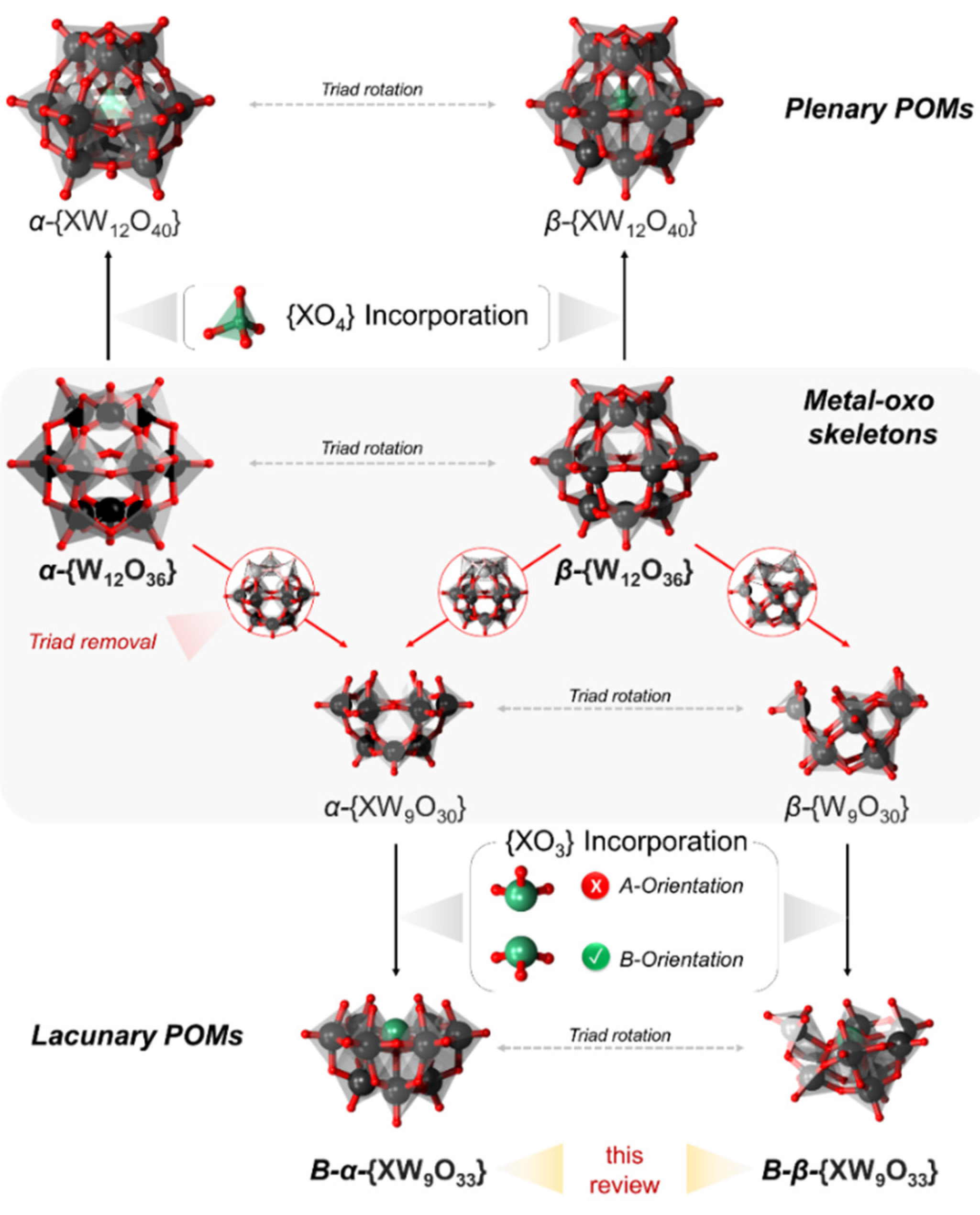

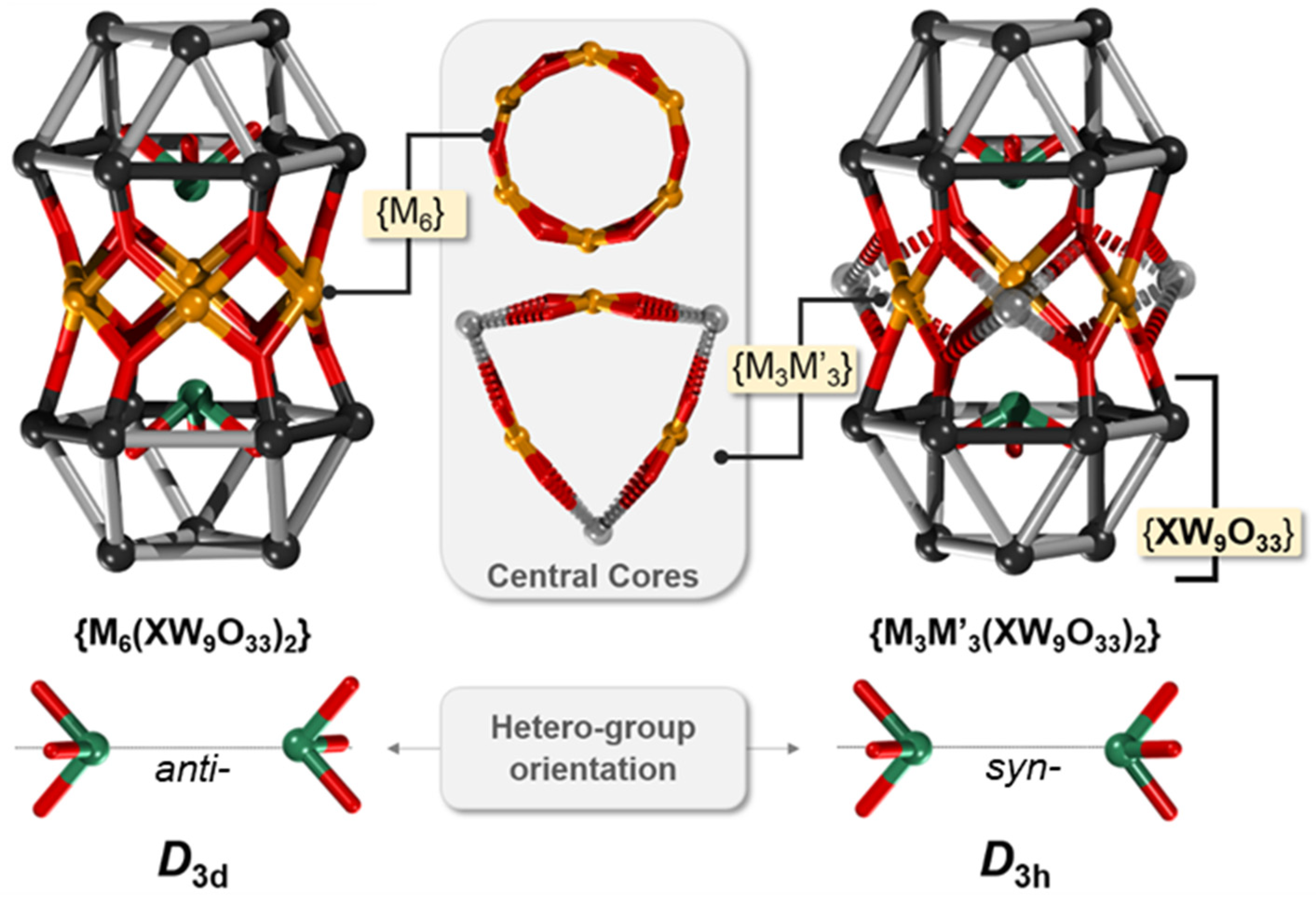
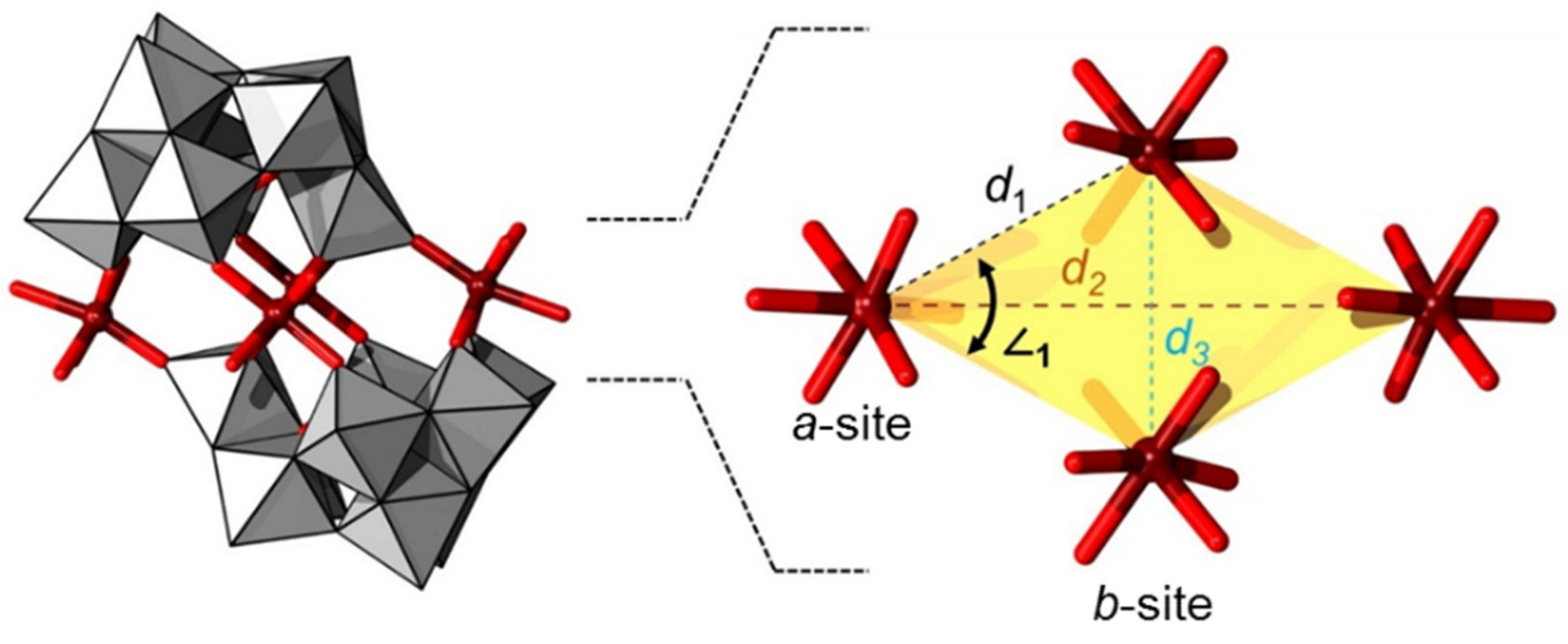

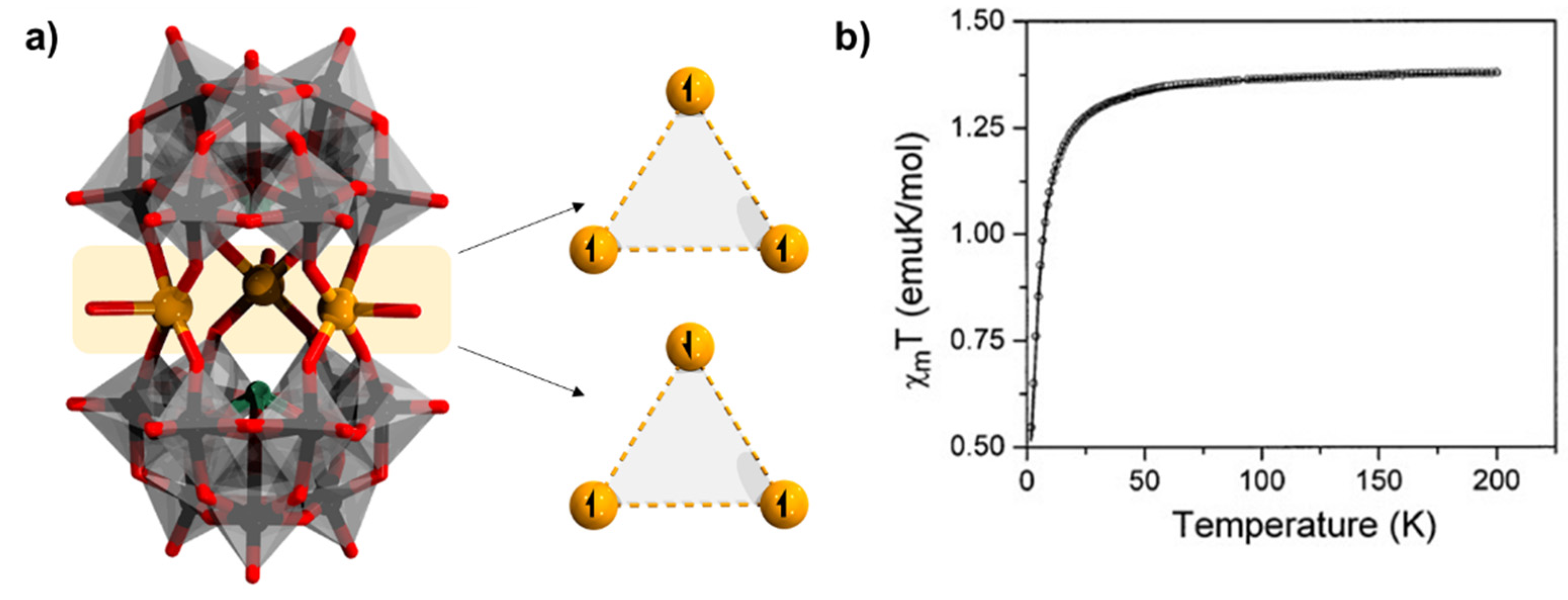

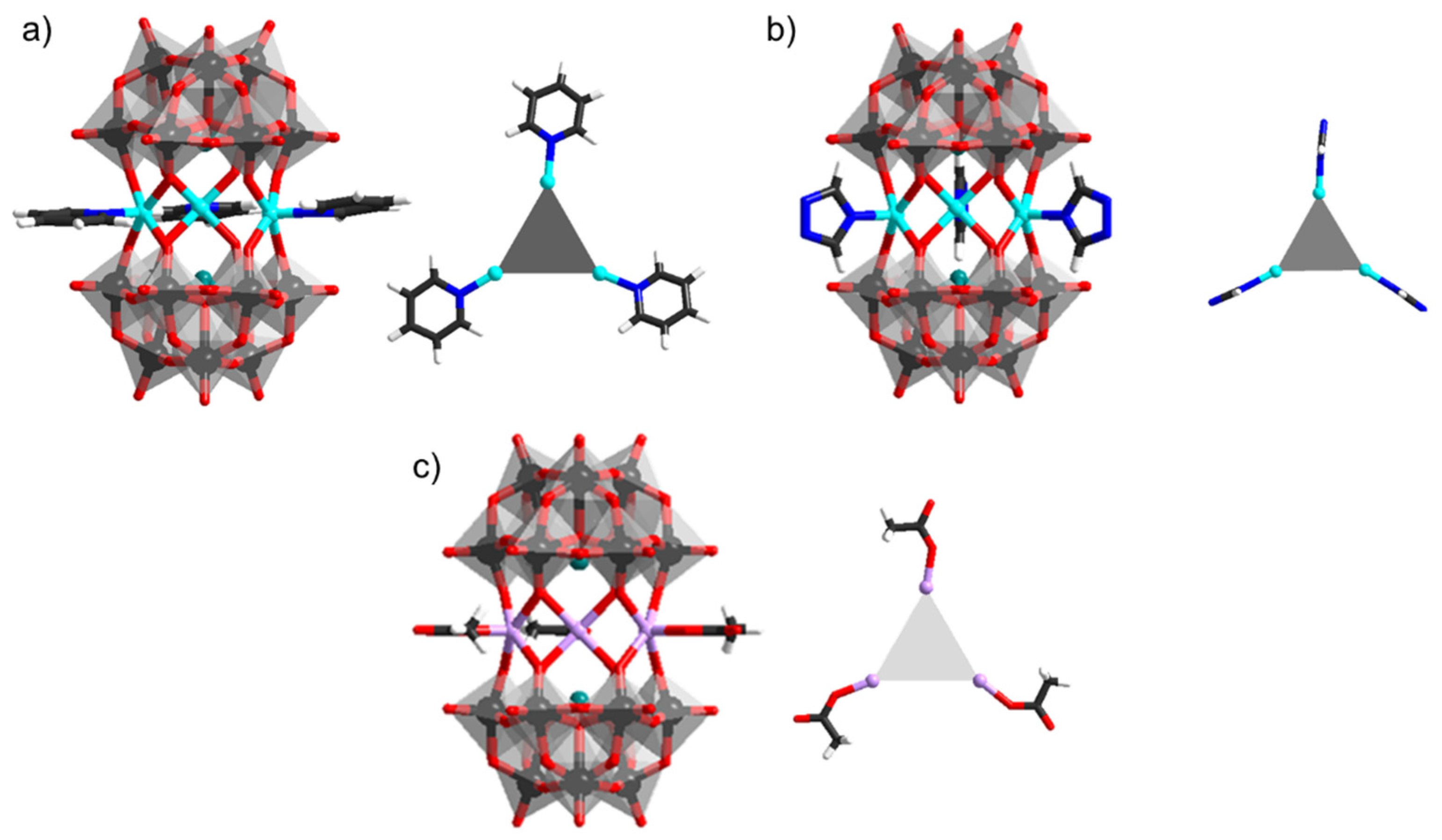
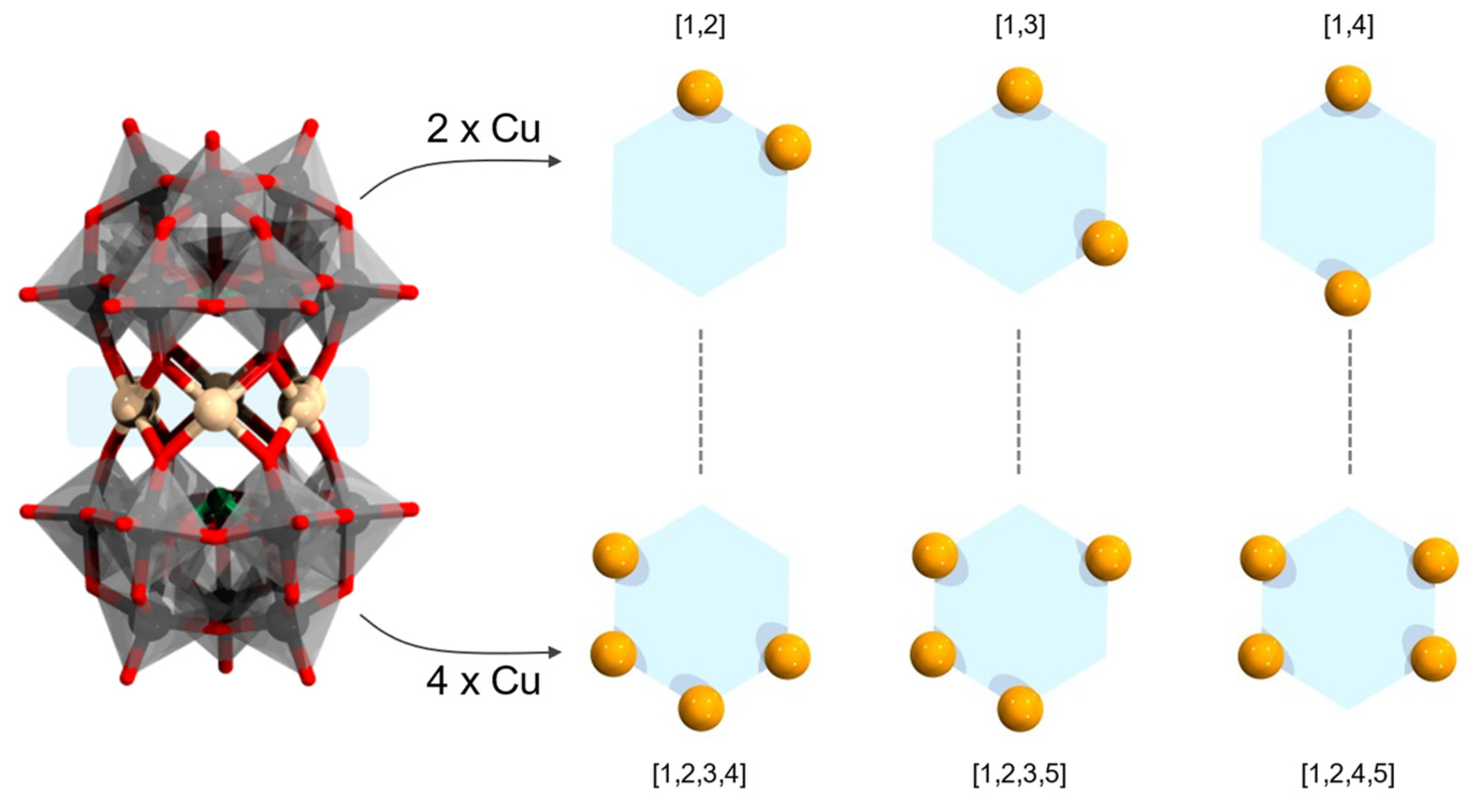
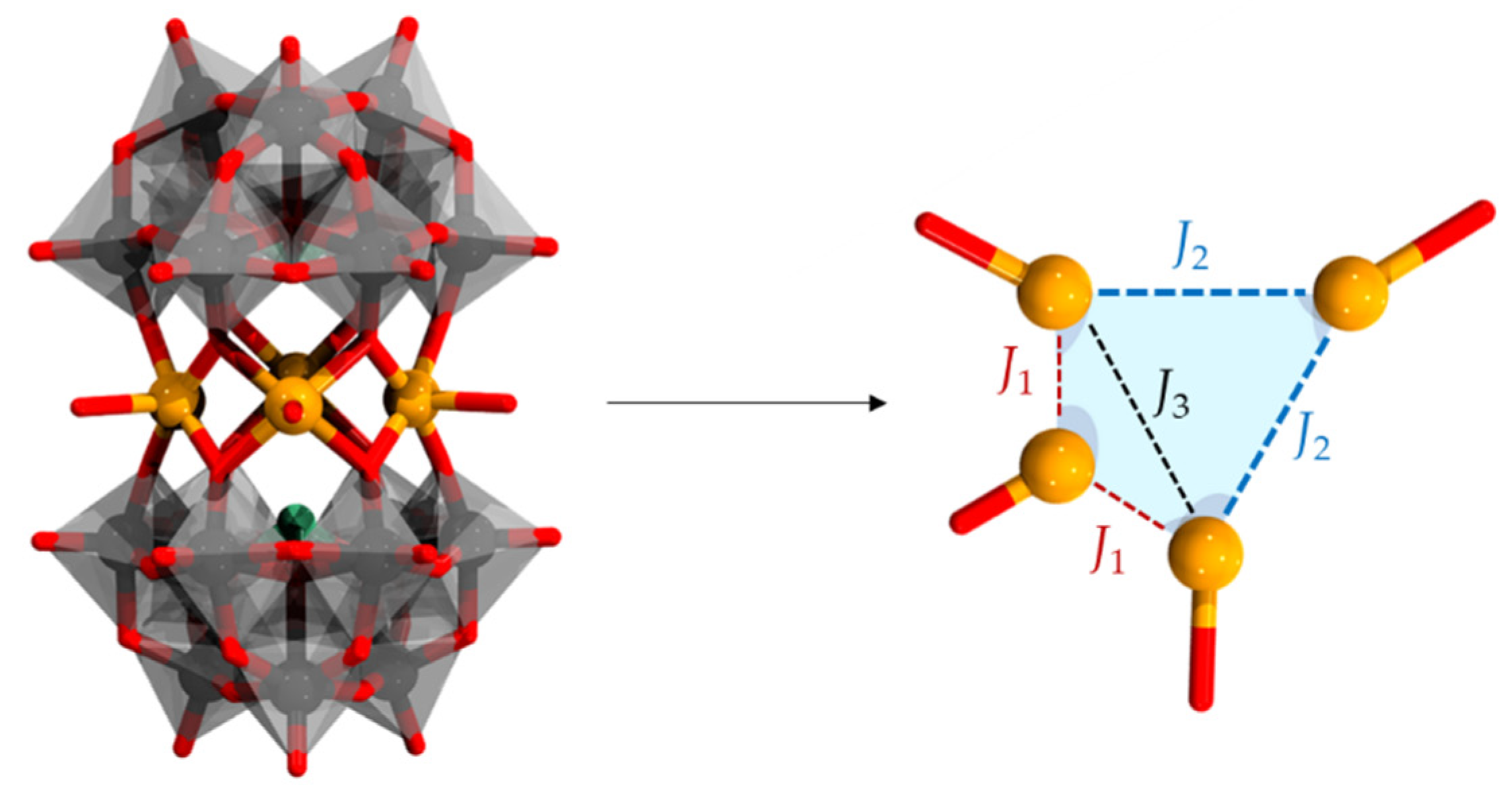
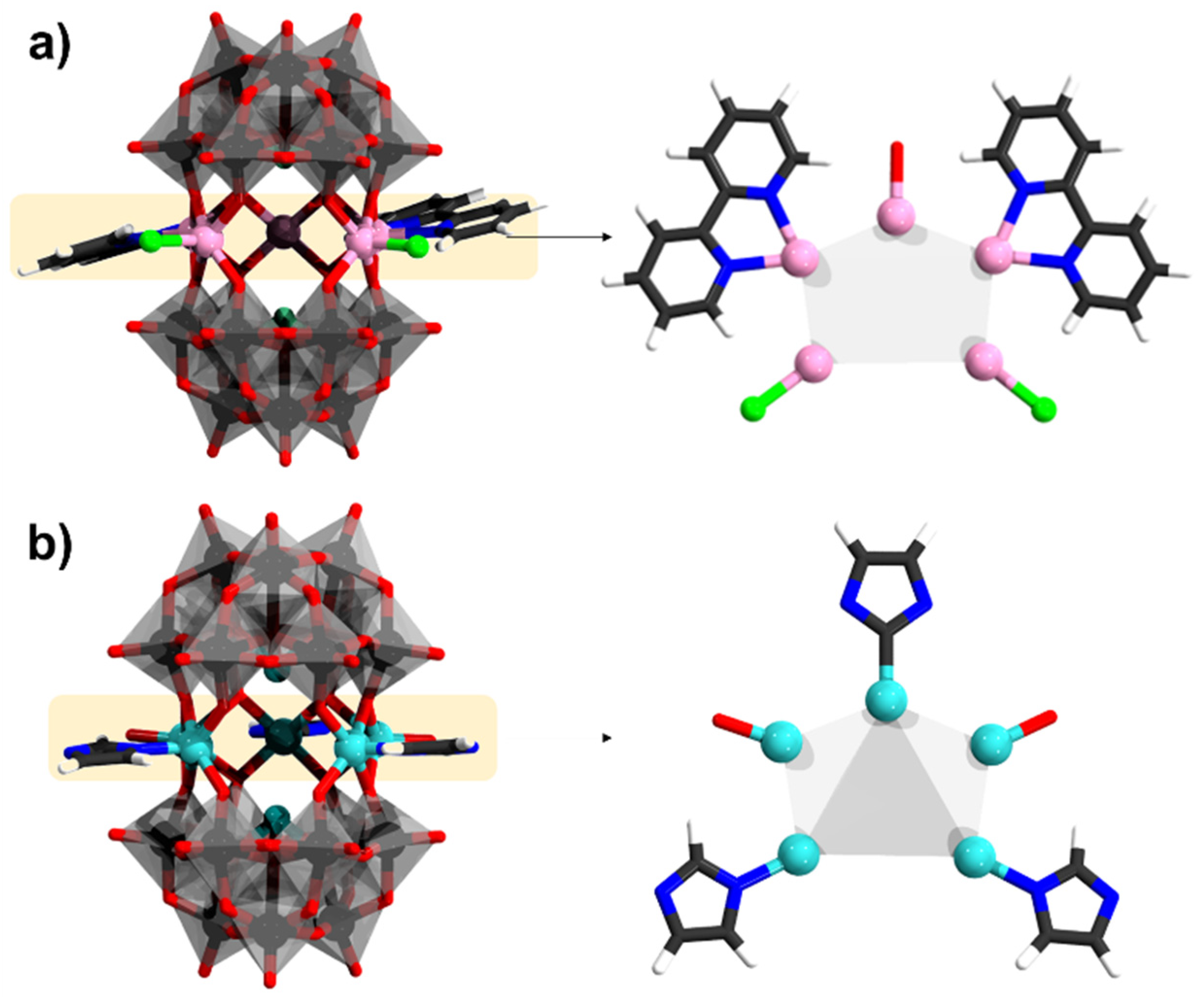
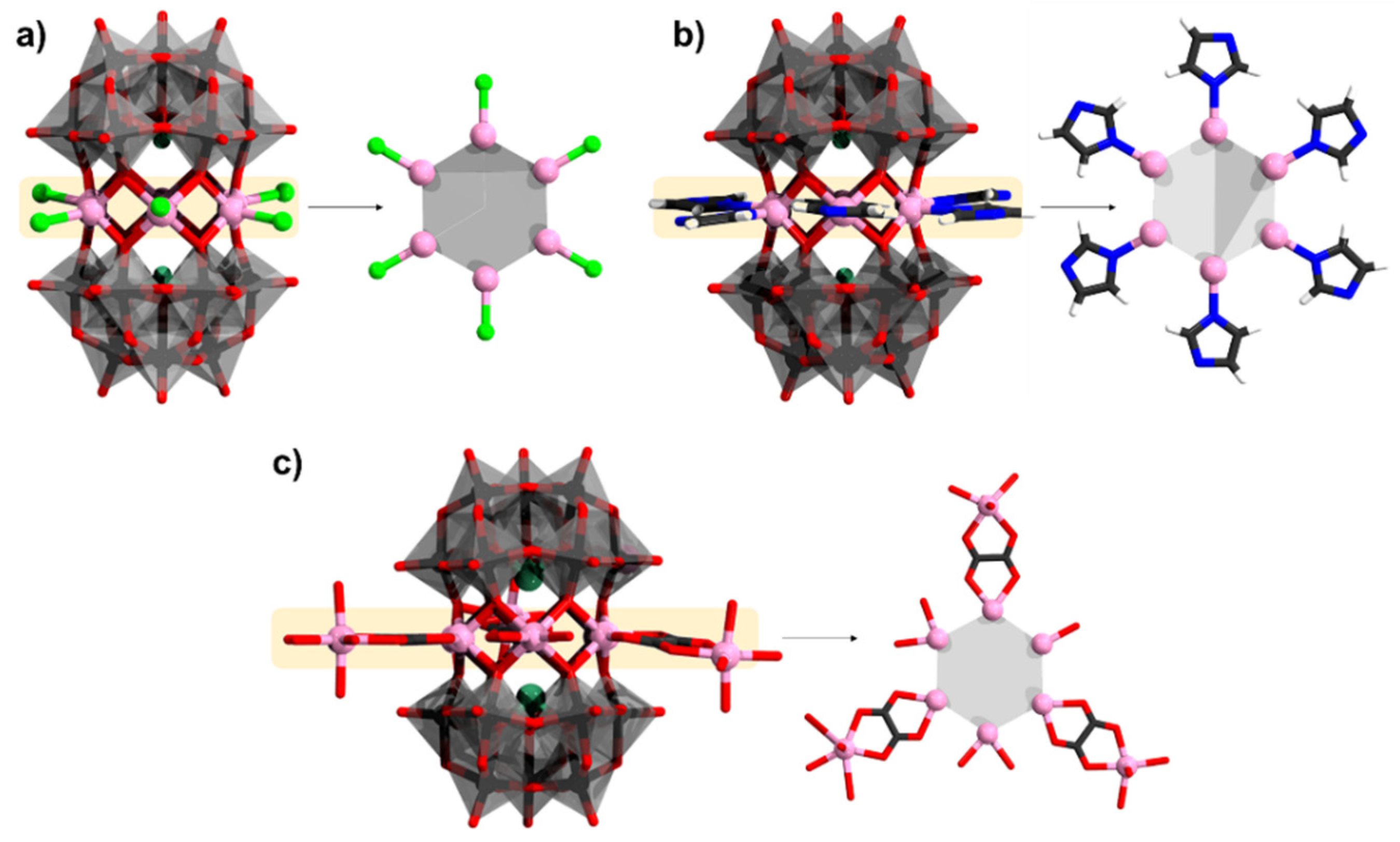
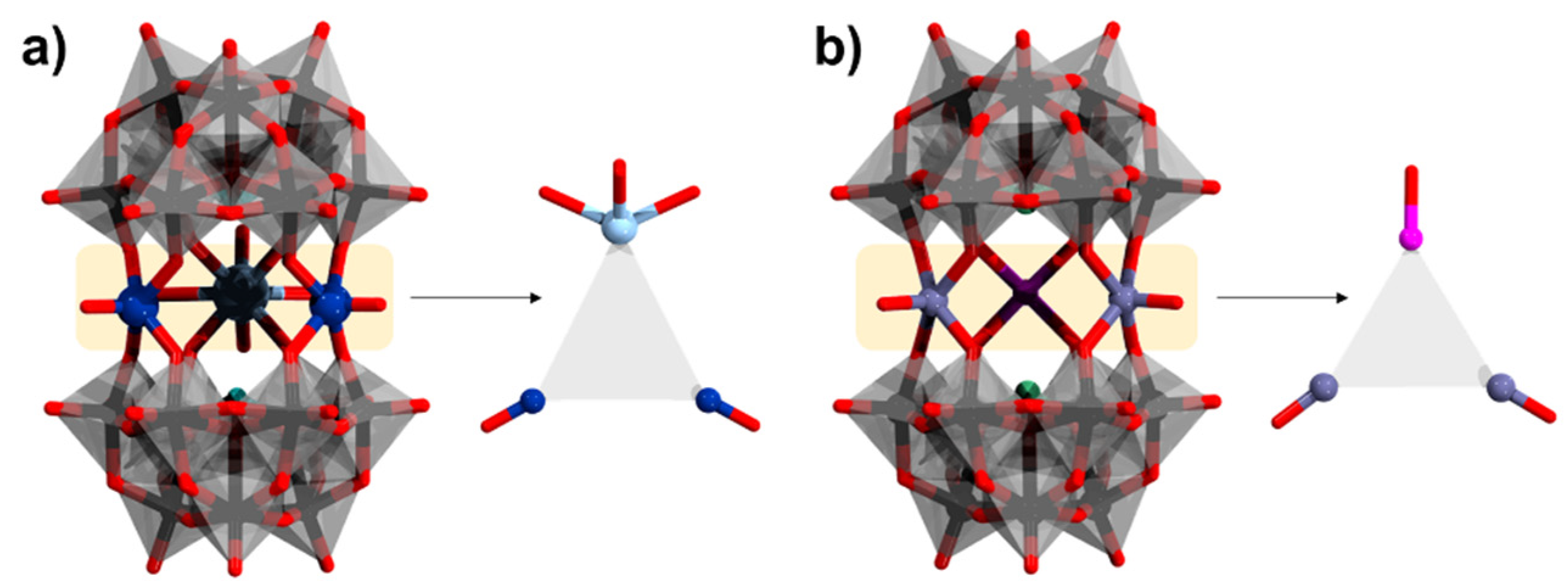
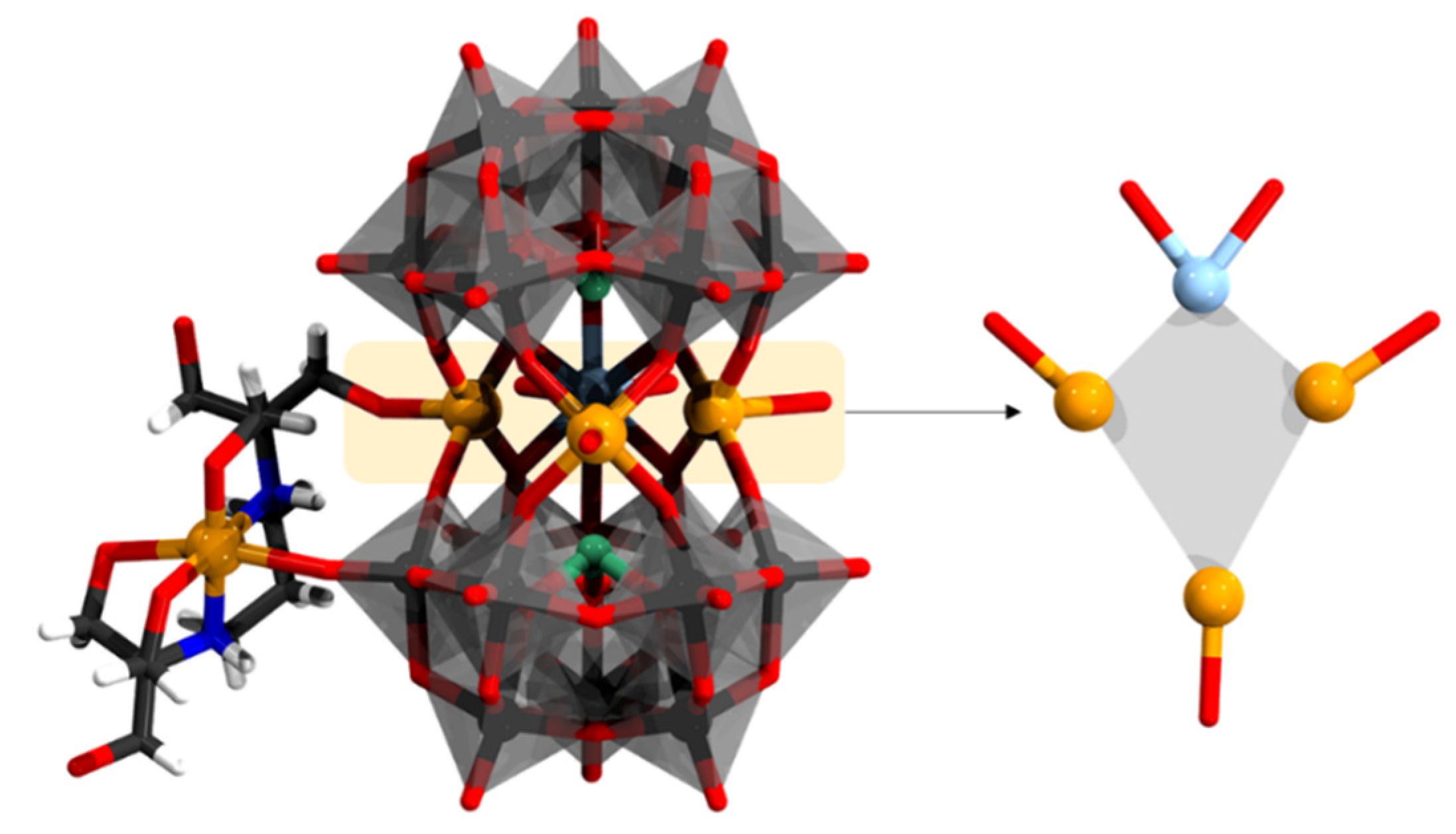
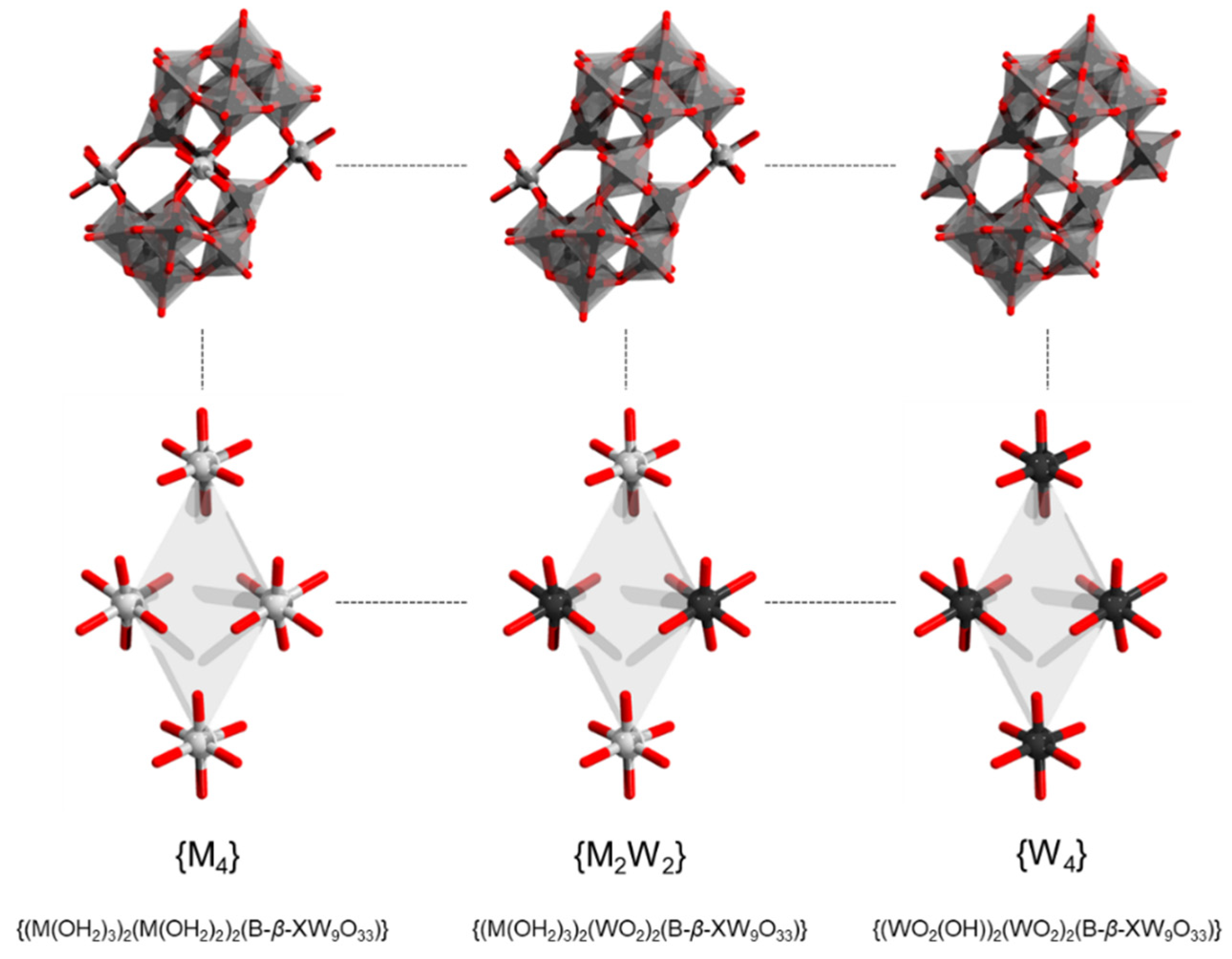
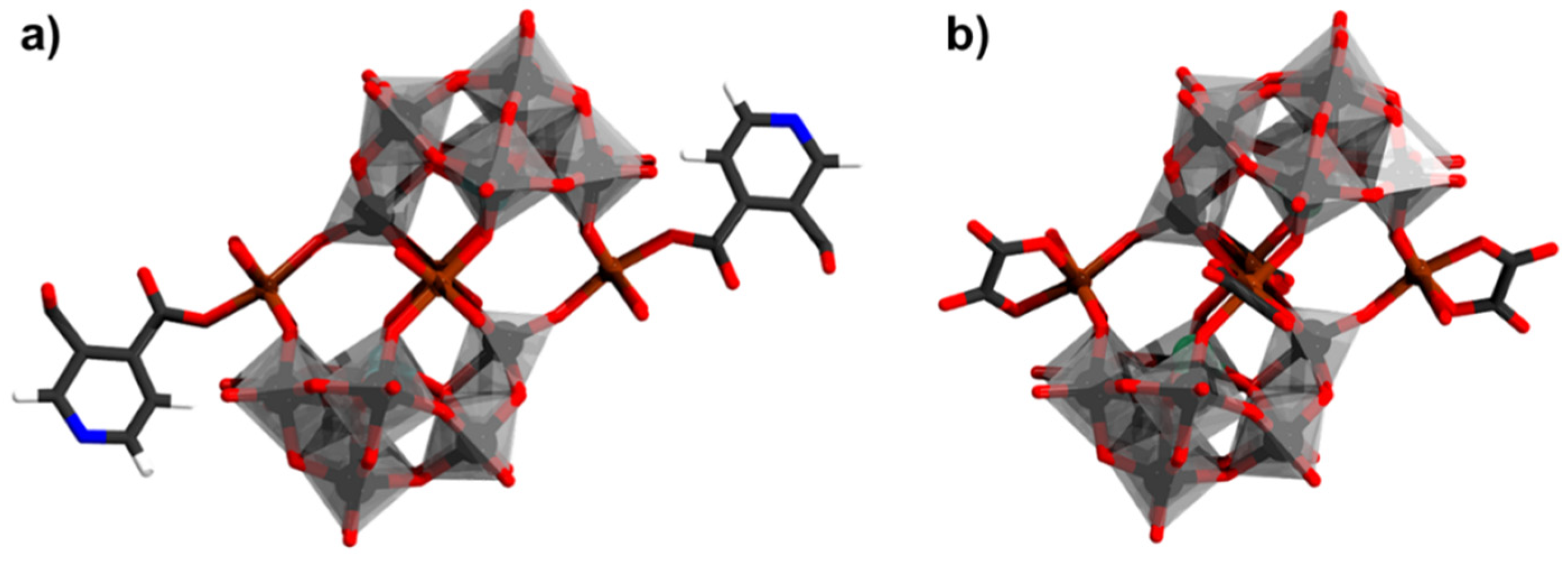
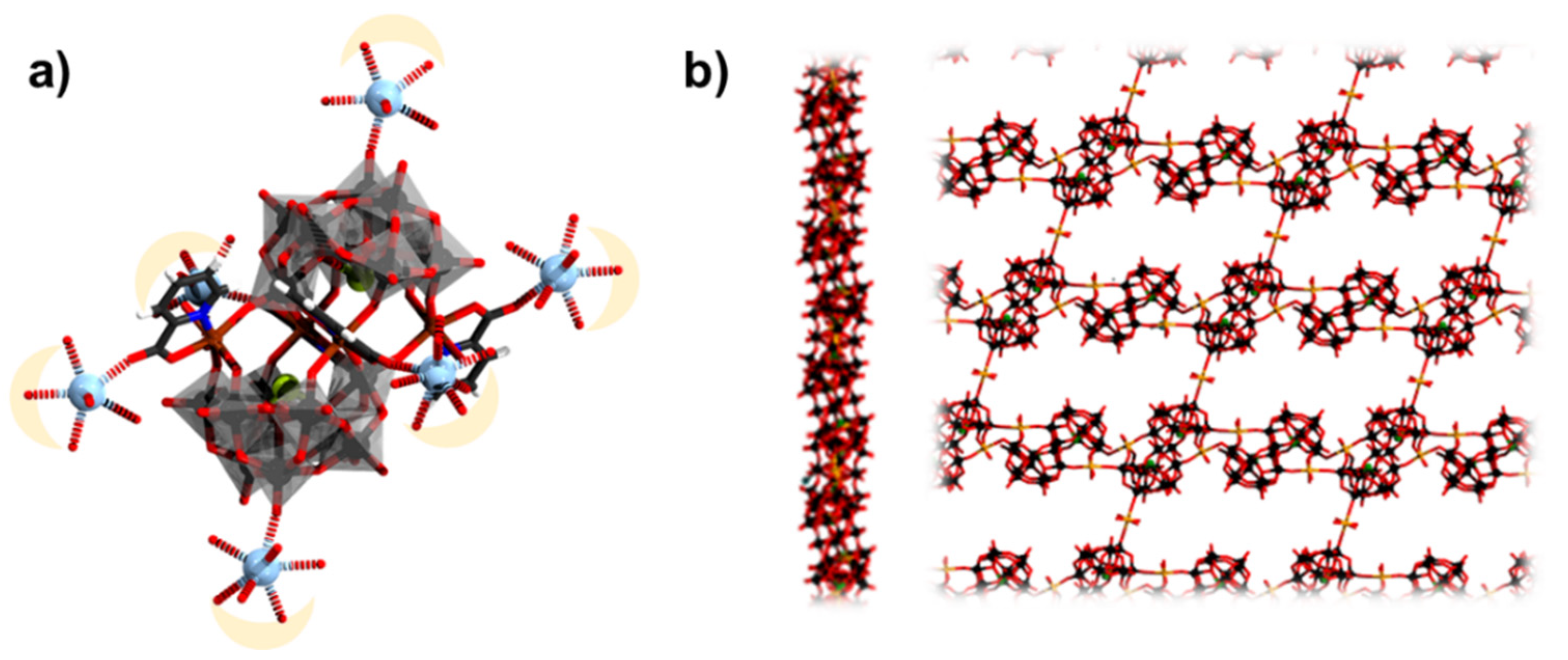
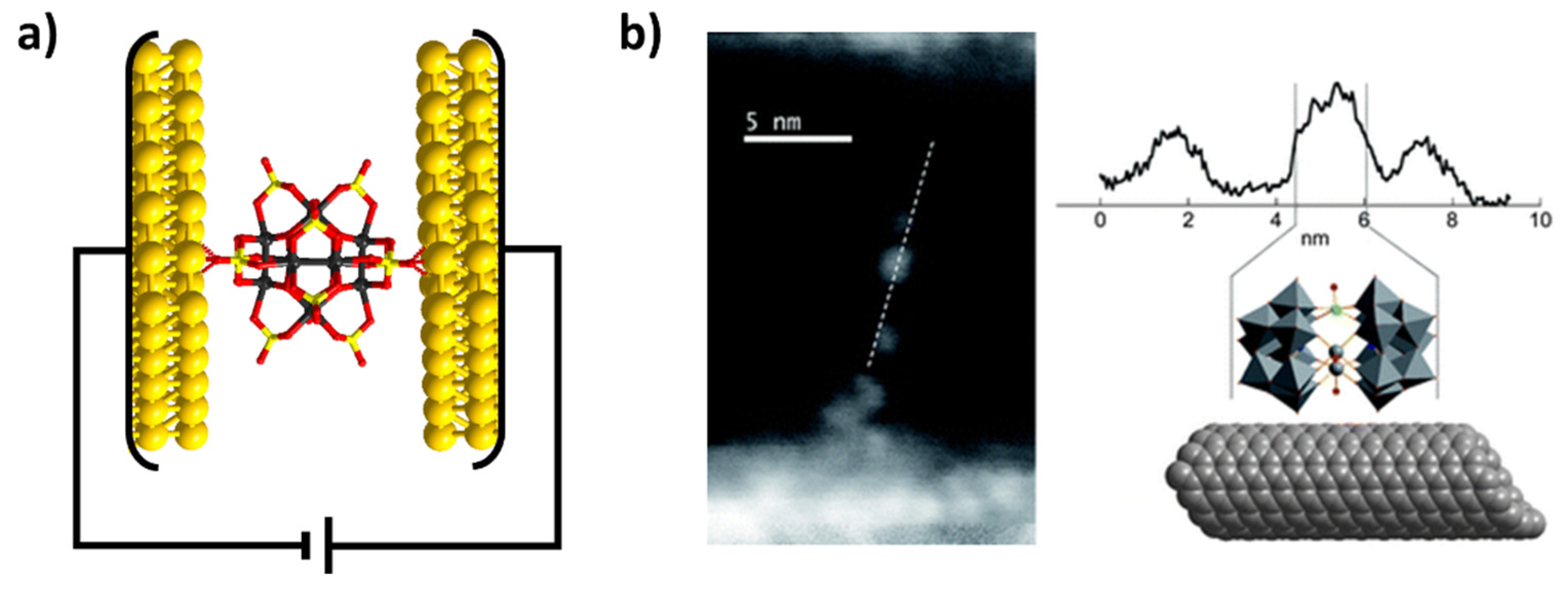
Publisher’s Note: MDPI stays neutral with regard to jurisdictional claims in published maps and institutional affiliations. |
© 2022 by the authors. Licensee MDPI, Basel, Switzerland. This article is an open access article distributed under the terms and conditions of the Creative Commons Attribution (CC BY) license (https://creativecommons.org/licenses/by/4.0/).
Share and Cite
Kondinski, A.; Banerjee, A.; Mal, S.S. Hervé- and Krebs-Type Magnetic Polyoxometalate Dimers. Magnetochemistry 2022, 8, 96. https://doi.org/10.3390/magnetochemistry8090096
Kondinski A, Banerjee A, Mal SS. Hervé- and Krebs-Type Magnetic Polyoxometalate Dimers. Magnetochemistry. 2022; 8(9):96. https://doi.org/10.3390/magnetochemistry8090096
Chicago/Turabian StyleKondinski, Aleksandar, Abhishek Banerjee, and Sib Sankar Mal. 2022. "Hervé- and Krebs-Type Magnetic Polyoxometalate Dimers" Magnetochemistry 8, no. 9: 96. https://doi.org/10.3390/magnetochemistry8090096
APA StyleKondinski, A., Banerjee, A., & Mal, S. S. (2022). Hervé- and Krebs-Type Magnetic Polyoxometalate Dimers. Magnetochemistry, 8(9), 96. https://doi.org/10.3390/magnetochemistry8090096







